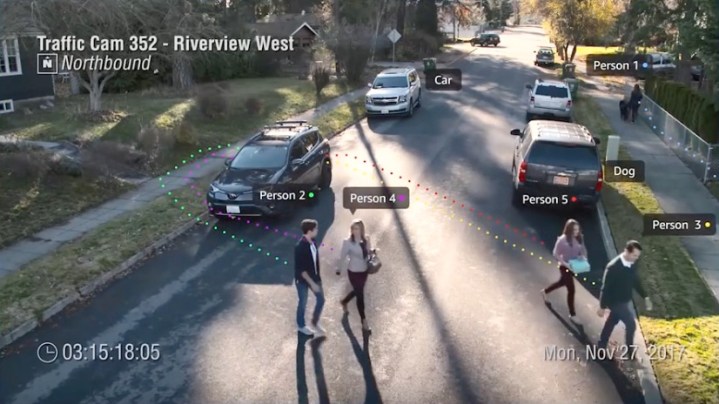2018 as a whole was equal parts weird, wonderful, and worrying. The same can be said of the science that happened this year. From a sun-bound space probe to controversial designer babies made by a rogue scientist, this year’s science headlines read like chapter titles to a cheap sci-fi novel.
- NASA’s Parker Solar Probe sets out for the sun
- Climate change keeps getting worse
- Return to the Red Planet
- A.I. art sells at auction
- Cigar-shaped comet might actually be an alien probe
- Mice with two mommies
- Einstein’s theory finally confirmed
- Chinese scientist claims to create world’s first designer babies
- Facial recognition: the good, the bad, the ugly
- DNA matching helps police pick out Golden State Killer suspect
- Boston Dynamics was at it again
- They killed the kilogram
- Male birth control
Here’s our recap — in no particular order — of some of the most outstanding scientific breakthroughs, news, and discoveries from the past 12 months.
NASA’s Parker Solar Probe sets out for the sun

NASA’s Parker Solar Probe had a bumpy beginning, as a series of budget cuts in the 2000s relegated the mission to a mere twinkle in the agency’s eye. But in August, the extraordinary probe, designed to study the sun from the very edge of its atmosphere, finally launched from the Space Launch Complex 37 at Florida’s Cape Canaveral Air Force Station.
Packed within the Parker Solar Probe’s heat shield are a slew of instruments designed to measure electric and magnetic fields within the sun’s corona and solar wind, transmitting that information back to astronomers on Earth for analysis. One of the mission’s primary goals is to reveal details about the origin of the solar winds that pose a significant threat to satellites, spacecraft, and communications systems.
Climate change keeps getting worse

Future generations will look back in disbelief at our inability to take immediate and comprehensive action on climate change. They’ll be right to do so. The signs have been written in bright neon lights for years. 2018 just circled those signs with red permanent marker.
A study early this year found that 2017 ranked as the hottest year on record without a water-warming El Niño. 2017 was also the costliest year for natural disasters in the United States. Full figures on 2018 have yet to be compiled.
But 2018 was climactically rough. The Eastern U.S. entered the new year chilled to the core by an extreme cold wave. Summertime brought a record setting heat wave to the British Isles and Europe. Fires blazed across California by fall. Hurricanes wreaked havoc around the world.
To drill the point home, a number of studies were published claiming change makes the world less safe and threatens our beer supply. Oh, and we have about 12 years to get our act together.
Return to the Red Planet

Something about Mars beckons human exploration. Maybe it’s the planet’s proximity, or perhaps its rusty twinkle inspires adventure. The Red Planet has been the subject of ancient myth, science fiction, and more space missions than any other place in the solar system other than the Moon.
But it’s been six years since we successfully visited the surface of our celestial neighbor. With the InSight Lander, which launched in May and landed successfully in November, NASA added another lander to the mix. Short for “Interior Exploration using Seismic Investigations, Geodesy and Heat Transport,” InSight will study the Martian core to detect possible seismic activity over the next two years. The goal is to better understand how rocky planets like Earth, Venus, and Mars form. In 21st century style, InSight celebrated its landing with a selfie.
A.I. art sells at auction

Artificial intelligence has been making “art” for years, and as A.I. systems have advanced, so too have the quality of their creations. 2018 saw perhaps the biggest breakthrough for the intersection of A.I. and art, when the historic auction house Christie’s sold its first painting created by a machine. Dubbed “Portrait of Edmond de Belamy,” the piece was expected to sell for up to $10,000. When the gavel finally fell, the sale price was a whopping $432,000. For now at least, it looks like art might be a viable option for A.I. after all.
Cigar-shaped comet might actually be an alien probe

When the comet Oumuamua (pronounced “oh-MOO-ah-MOO-ah”) grabbed headlines in November 2017, it did so as a foreigner, the first comet ever recorded to originate from interstellar space. What made the comet even more unusual was its elongated shape. Oumuamua entered our solar system looking like some sort of celestial cigar. We should have known the weird news wouldn’t stop there.
A year after the initial announcement of its discovery, a team of Harvard astrophysicists proposed a theory for Oumuamua’s origins that involved an ever-elusive space sci-fi trope: aliens.
In a paper published in The Astrophysical Journal Letters, the Harvard astrophysicists claimed Oumuamua could be “a fully operational probe sent intentionally to Earth vicinity by an alien civilization.” Of course, their suggestion should be taken with a grain of salt. But it’s intriguing nonetheless.
Mice with two mommies

In one of this year’s biggest reproductive breakthroughs, healthy mice were born with two genetic mothers and even went on to bear offspring of their own, according to a paper out of the Chinese Academy of Sciences in October. The researchers used gene editing and stem cells to cultivate the pups with two moms. The feat hadn’t previously been successfully achieved in mammals.
Mammalian offspring typically require genetic material from both male and female parents to survive and live healthily. This study demonstrated that the offspring could be born healthy and even go on to have their own young. The findings may lay groundwork for future reproductive breakthroughs in humans.
Einstein’s theory finally confirmed

A century after Einstein first proposed general relativity, astronomers confirmed his theory by observing the gravitational redshift of stars near a supermassive black hole at the center of the galaxy. Equipped with the European Southern Observatory’s Very Large Telescope (VLT), the international team of astronomers watched how a black hole’s extreme gravitational field impacted an encroaching star’s motion. As Einstein predicted, the star’s light was stretched to longer wavelengths. The observation was the culmination of a 26-year-long project.
Chinese scientist claims to create world’s first designer babies
In arguably the most controversial move in science this year, a Chinese scientist claimed he altered the DNA of twin girls, creating the world’s first genetically engineered babies. The announcement was met with assertions from his peers that the work was unethical, dangerous, and even “monstrous.” Developing designer babies is banned in most countries.
For some time now, Chinese researchers have sought participants for a trial designed to eliminate a gene in offspring that could make them resistant to diseases such as HIV, smallpox, and cholera. Documents related to the clinical trial have been traced back to March 2017. The scientist’s claims haven’t been verified and many experts have expressed doubt.
Facial recognition: the good, the bad, the ugly

Facial recognition software has made leaps and bounds in the past few years. The progress is apparently enough for some law enforcement, including the City of Orlando’s police department, to deploy the software on its citizens. In May, the American Civil Liberties Union published documents showing that Orlando police acquired access to Amazon’s real-time “Rekognition” facial recognition technology to help prevent crime. Earlier this year, Chinese police implemented similar measures.
One month later, facial recognition software was in the news again, when it helped police identify the Capital Gazette killer. However, the software is far from perfect, as the ACLU demonstrated in July. Rekognition incorrectly classified 28 congressmembers as police suspects — with a disproportionate number of them being black and Latino.
DNA matching helps police pick out Golden State Killer suspect

Speaking of catching killers with 21st century tech, California police finally nabbed the suspected Golden State Killer in April using DNA from commercial DNA ancestry-tracking companies. With access to hundreds of thousands of samples on GEDMatch, an open-source genetic platform, officials were able to narrow their search, eventually landing on suspect Joseph James DeAngelo Jr. with matches from his third and fourth cousins. The move raised questions about privacy and safety. Should governments and companies have access to our genetic information? And, if so, what should they be allowed to do with that data?
Boston Dynamics was at it again
The engineers over at Boston Dynamics unveiled some pretty outstanding machines this year. Never before have robots been so athletic. From their dancing robot dog, SpotMini, to a bipedal Atlas robot, which tackled parkour-style obstacles better than most humans we know, Boston Dynamics gave us a glimpse at how far robots have come — and how far they might go in the foreseeable future. If a picture is worth a thousand words, the company’s 2018 videos fill volumes.
They killed the kilogram

A 129-year-old-tradition was squashed in November when meterologists voted to effectively kill the kilogram. Since 1889, the International Prototype Kilogram (IPK), a block of platinum and iridium locked in a subterranean vault in Paris, had served as the standard for all related measurements in the world.
But, over time, the IPK (and its many replicates around the world) are subject to detectable if slight wear and tear that causes them to lose weight. So, at the General Conference on Weights and Measures in Versailles, France, scientists decided to get rid of the physical objects and express metric units in terms of fundamental constants. Weights will henceforth be expressed in terms of the Planck constant (h). The decision doesn’t mean much (if anything) for the average person, but proponents have said it will pave the way for more accurate and stable measurements.
Male birth control
For all the ways science has advanced over the years, male contraceptives remain behind the times. You essentially have two options: condoms or vasectomy. But this year researchers and some couples embarked on a trial testing a contraceptive gel, which, when rubbed into the upper arms and shoulders, is designed to lower sperm count below the threshold for pregnancy. Hundreds of eager beavers have signed up to participate in the trial, which will entail using the gel as their sole contraceptive for a year. The researchers plan on publishing their results in 2022. If all goes well, men may soon have a reversible, affordable, and safe option to postpone parenthood.


